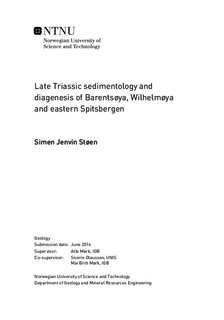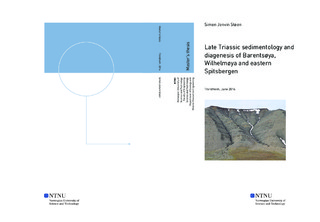| dc.description.abstract | This study documents and discusses the sedimentology and diagenesis of the Triassic De Geerdalen Formation on eastern Svalbard. In addition to sandstone sampling, nine sedimentary sections have been measured. These include the mountains of; Klement evfjellet, Friedrichfjellet and Smidtberget in Agardhbukta, Teistberget and Hellwaldfjellet on eastern Spitsbergen, Krefftberget, Svartnosa and Mistakodden on Barentsøya and Tumlingodden on Wilhelmøya. Based on field observations 15 facies have been defined. In turn, these have been grouped into eight facies associations that reflect environments on the marine offshore to lower shoreface (FA 1), delta front (FA 2) and delta plain (FA 3). The interpretations presented herein, is based on previous reseach in adjacent areas and cooperation with other master students. Thin section analysis and SEM investigations have been applied in order to complement sedimentological analysis, with data on sediment texture and composition, and to document factors affecting porosity in the sandstones. The De Geerdalen Formation represents a major shallowing upward sequence, and the establishment of a paralic delta plain environment is documented in the upper part of measured sections. Recurring upwards coarsening and shallowing parasequences reflects a dynamic delta nature. Delta front facies on Barentsøya and Teistberget show a fluvial dominance upon deposition, in a proximal setting (relative to a westwards prograding distributary system) compared to visited outcrops on Spitsbergen. Towards the southern (Agardhbukta) and northern exposures (Hellwaldfjellet and Wilhelmøya) thinning of delta front sandstones (FA 2) and increased influence of basinal processes upon sedimentation is documented. Distribution of porosity in the studied deltaic sandstones is largely controlled by diagenetic processes. Locally, early calcite cement has inhibited mechanical compaction, allowing an open sandstone fabric and intergranular porosity where cementation shows a patchy distribution. However, calcite cement is commonly extensive and the majority of porosity occurs as poorly connected molds. Other authigenic minerals include siderite, kaolinite, illite, chlorite, albite and quartz, with precipitation often associated with dissolution of unstable lithic fragments. Mechanisms affecting porosity are closely related to the immature composition of the De Geerdalen Formation sandstones. | |

